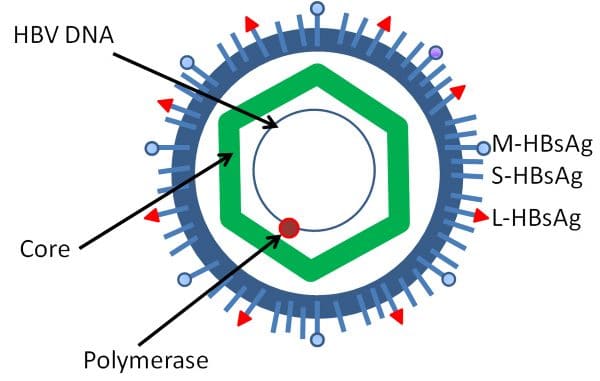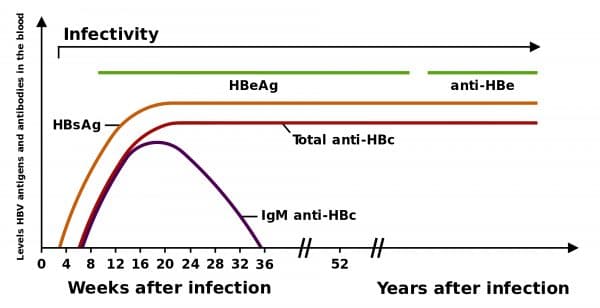- 📖 Geeky Medics OSCE Book
- ⚡ Geeky Medics Bundles
- ✨ 1300+ OSCE Stations
- ✅ OSCE Checklist PDF Booklet
- 🧠 UKMLA AKT Question Bank
- 💊 PSA Question Bank
- 💉 Clinical Skills App
- 🗂️ Flashcard Collections | OSCE, Medicine, Surgery, Anatomy
- 💬 SCA Cases for MRCGP
To be the first to know about our latest videos subscribe to our YouTube channel 🙌
Introduction
Hepatitis B is an infection of the liver caused by the hepatitis B virus (HBV). Hepatitis B serological testing involves the measurement of several different HBV-specific antigens and antibodies, enabling differentiation between infection (acute or chronic) and immunity (from vaccination or cleared infection). Therefore, the ability to interpret HBV serology is a crucial skill to develop.
Background
Transmission
HBV is transmitted via parenteral routes, either via infected blood or bodily fluids. Transmission is typically through sexual intercourse (vaginal or anal) or blood-to-blood contact (e.g. intravenous drug use, needlestick injuries).1 HBV may also be acquired via vertical transmission (mother to infant during pregnancy or delivery).2
Clinical course
HBV infection results in a spectrum of clinical presentations, ranging from asymptomatic, self-limiting disease to a persistent infected state with a subsequent high risk of developing hepatocellular carcinoma and decompensated liver failure. Ultimately, the severity of illness is influenced by the host response to HBV.
The incubation period of HBV ranges from 45 to 200 days, with an average time span of approximately 75 days.2 This is a clinically relevant period, as there is a notable gap between initial infection and the appearance of HBV viral antigens and antibodies.
The likelihood of progression from acute to chronic infection depends on numerous factors, including the duration of infection and immunocompetency. 2
HBV is a member of the Hepadnavirus family and is a circular, partially double-stranded DNA virus. 1 The virus contains three surface antigens that are commonly tested for in clinical practice. These antigens will be discussed in the serology section.

Clinical features
Acute hepatitis infection
Up to 50% of patients with acute HBV infection will experience subclinical or anicteric hepatitis (i.e. no associated jaundice).1
In the remaining patients, typical symptoms of acute HBV infection include1:
- Constitutional symptoms (e.g. weight loss, fever, fatigue)
- Nausea
- Anorexia
- Right upper quadrant pain
- Jaundice
Chronic hepatitis infection
In chronic HBV infection, there are typically no physical signs unless complications of long-standing infection arise. Patients with chronic infection may show signs of chronic liver disease or hepatocellular carcinoma.4
Serological testing
The serological markers of HBV infection include diagnostically relevant viral antigens, viral DNA and corresponding antibodies.
Surface antigen and antibody
Hepatitis B surface antigen (HBsAg)
The hepatitis B surface antigen (HBsAg) is a protein found on the surface of HBV; it is the first serum marker to be detected following initial infection. Whilst it is the first antigen to appear, it is important to note, there is a window period of up to 200 days (average 75 days) between the first exposure to HBV and the detection of HBsAg in the serum.2
HBsAg seroconversion is the development of antibodies against HBsAg (anti-HBs); it indicates the clearance of HBsAg and the resolution of infection.5 The presence of HBsAg always implies active infection, whilst persistence of HBsAg for more than six months indicates chronic infection.5
Antibody to Hepatitis B surface antigen (anti-HBs)
Anti-HBs is the antibody produced by the host in response to HBsAg (HBsAg seroconversion). The presence of anti-HBs without HBsAg indicates two possible scenarios: either previous, cleared infection or vaccination against hepatitis B virus – distinguishing between these two scenarios is possible with further serological testing. Anti-HBs remains in serum for life and indicates immunity to HBV.
Core antigen and antibody
Hepatitis B core antigen (HBcAg)
The hepatitis B core antigen (HBcAg) is part of the nucleocapsid within HBV; it is not routinely measured in clinical practice; however, the body produces a corresponding antibody to this antigen called hepatitis B core antibody (anti-HBc), which is clinically relevant.
Antibody to Hepatitis core antigen (anti-HBc):
Anti-HBc is the antibody produced by the host in response to HBcAg; depending on which immunoglobulin type is present indicates the time frame since infection. The presence of anti-HBc IgM indicates recent infection within the last six months.1 Over time, IgM is gradually replaced by anti-HBc IgG; therefore, anti-HBc is seen in patients with resolved infection and those with chronic infection.1 This is shown in Figure 2, as anti-HBc IgM acutely rises and falls, whilst total anti-HBc rises and plateaus as IgG production predominates.6

Envelope antigen and antibody
Hepatitis B envelope antigen (HBeAg)
The hepatitis B envelope antigen (HBeAg) is found between the core and lipid envelope within HBV and is present in both acute and chronic infection. The presence of HBeAg in serum indicates active viral replication and a higher risk of transmissibility.1 HBeAg can be therefore used to distinguish between active chronic infection and inactive chronic infection.
Hepatitis B envelope antibody
HBeAg seroconversion is the development of antibodies against HBeAg (anti-HBe); it marks a transition from active disease to an inactive ‘carrier’ state.5 Anti-HBe remains in serum for life and indicates acquired, natural immunity (i.e. immunity from a previous infection only).
Hepatitis B virus DNA (HBV-DNA)
In patients with serological markers indicating infection, quantification of HBV-DNA is often performed.1 A high HBV-DNA viral load is associated with an increased risk of progression to cirrhosis and hepatocellular carcinoma (HCC).1 In patients with active chronic infection, a higher HBV-DNA viral load is expected.
Summary tables
The table below summarises the interpretation of hepatitis B serological tests.
Abbreviations:
- + detectable in serum
- – not detectable in serum
Table 1. Interpretation of all serological tests for hepatitis B
|
|
Hep B surface antigen (HBsAg) | Antibody to Hep B surface antigen (anti-HBs) | Hep B envelope antigen (HBeAg) | Antibody to Hep B envelope antigen (anti-HBe) | Anti-HBc IgM | Anti-HBc IgG | HBV DNA |
|
Acute infection |
+ |
– |
+ |
– |
+ |
– |
+ |
|
Chronic infection (active) |
+ |
– |
+ |
– |
– |
+ |
+ (High) |
|
Chronic infection (inactive, carrier) |
+ |
– |
– |
+ |
– |
+ |
+ (Low) |
|
Immunity (following acute infection) |
– |
+ |
– |
+ |
– |
+ |
– |
|
Immunity (following vaccination) |
– |
+ |
– |
– |
– |
– |
– |
It’s also important to consider hepatitis serology in context, by taking into account the effect of on transaminases.1
Table 2. Effect of infection status on transaminases
|
|
Transaminases |
|
Acute hepatitis B infection |
Elevated |
|
Chronic hepatitis B infection (active) |
Elevated |
|
Chronic hepatitis B infection (carrier) |
Normal |
|
Immunity (following acute infection) |
Elevated or normal |
|
Immunity (following vaccination) |
Normal |
Vaccination against hepatitis B
In the UK, there are several hepatitis B vaccines licensed for use in children and adults in ‘high-risk groups’; this includes people at a high risk of exposure to HBV or subsequent complications from HBV infection.7
The vaccine contains inactivated hepatitis B surface antigen (HBsAg) prepared from yeast cells using recombinant DNA technology.7 The immune system generates the corresponding antibody (anti-HBs) and establishes memory cells against the virus. The vaccine only exposes individuals to HBsAg; therefore, vaccinated individuals only show anti-HBs in the serum.
Editor
Dr Lewis Potter
References
- National Institute for Health and Care Excellence (2021) Hepatitis B [LINK]
- Health and Safety Executive (2021) Blood borne viruses – Hepatitis B [LINK]
- Wikipedia/Dr Graham Beards. The structure of hepatitis B virus. Licence [CC BY-SA]. Available from [LINK]
- Centers for Disease Control and Prevention (2021) Hepatitis B [LINK]
- National Institute for Health and Care Excellence (2017) Hepatitis B (chronic): diagnosis and management [LINK]
- Wikipedia/Offnfopt. Chronic HBV diagram. Licence [CC BY-SA]. Available from [LINK]
- British National Formulary (2021) Hepatitis B vaccine. [LINK]




